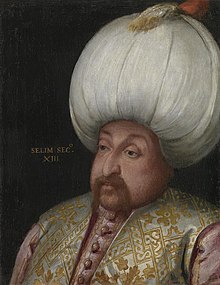Selim II (Ottoman Turkish: سليم ثانى Selīm-i sānī, Turkish: II. Selim; 28 May 1524 – 15 December 1574), also known as Selim the Blonde (Turkish: Sarı Selim) or Selim the Drunk (Turkish: Sarhoş Selim), was the Sultan of the Ottoman Empire from 1566 until his death in 1574. He was a son of Suleiman the Magnificent and his wife Hurrem Sultan. Selim had been an unlikely candidate for the throne until his brother Mehmed died of smallpox, his half-brother Mustafa was strangled to death by the order of his father, his brother Cihangir succumbed to chronic health issues, and his brother Bayazid was killed on the order of his father after a rebellion against Selim. Selim also ordered the Ottoman forces to set out from Istanbul and join with the Crimean Tatars in order to take part in the burning of Moscow in 1571. Although he succeeded in pacifying the Tsardom of Russia through the destruction of Moscow, Selim suffered a devastating defeat at hands of the Holy League armada led by the Spanish Empire in the naval Battle of Lepanto in which the Ottoman fleet was destroyed. Selim died on 15 December 1574 and was buried in the Hagia Sophia mosque in Istanbul. He was succeeded by Murad III.
| Selim II | |||||
|---|---|---|---|---|---|
| Kayser-i Rûm Ottoman Caliph Amir al-Mu'minin Custodian of the Two Holy Mosques | |||||
 Selim's portrait | |||||
| Sultan of the Ottoman Empire (Padishah) | |||||
| Reign | 7 September 1566 – 15 December 1574 | ||||
| Sword girding | 8 September 1566 | ||||
| Predecessor | Suleiman I | ||||
| Successor | Murad III | ||||
| Born | 28 May 1524[1] Istanbul, Ottoman Empire | ||||
| Died | 15 December 1574 (aged 50) Istanbul, Ottoman Empire | ||||
| Burial | |||||
| Spouse | |||||
| Issue | Şah Sultan Gevherhan Sultan Ismihan Sultan Murad III Fatma Sultan Others | ||||
| |||||
| Dynasty | Ottoman | ||||
| Father | Suleiman I | ||||
| Mother | Hurrem Sultan | ||||
| Religion | Sunni Islam | ||||
| Tughra |  | ||||
References
change- ↑ Emecen, Feridun (2009). "Selim II". TDV Encyclopedia of Islam, Vol. 36 (Sakal – Sevm) (in Turkish). Istanbul: Turkiye Diyanet Foundation, Centre for Islamic Studies. pp. 414–418. ISBN 978-975-389-566-8.
- ↑ Garo Kürkman, (1996), Ottoman Silver Marks, p.41